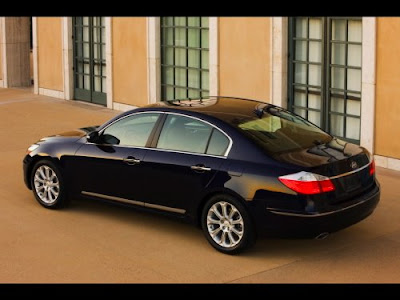 * Budget minded, yet well equipped:
* Budget minded, yet well equipped: Pricing starts at $14,550 with A/C, AM/FM/CD stereo, power windows and locks standard.
* Class-leading fuel economy: Up to 35 miles per gallon highway with the 5-speed automatic transmission.
* New tech options: GPS navigation & VSA stability control debut this year.
REVIEW:As we reported yesterday, the all-new 2009 Fit is coming to the US market a month early to keep pace with blockbuster sales.
As promised, here's the low-down on what's new and improved.
* More power, better fuel economy, nimble handling:First, to the engine room. The 1.7-litre SOHC inline-four returns year, this time with i-VTEC control for added power and efficiency. The new engine produces 117 horsepower at 6600 rpm and 106 lb-ft. of torque at 4800 rpm and can be mated to a 5-speed manual or optional automatic transmission, which on the Fit Sport, features steering wheel-mounted paddle shifters for manual gear control.
Surprisingly enough, the base Fit with an automatic transmission walks away with the MPG crown this time, besting the 5-speed manual in the EPA tests by one mpg in the city and two on the highway. The Fit Sport with either a manual or the optional automatic transmission achieve an EPA city/highway fuel economy rating of 27 and 33 miles per gallon.
In addition to being a fuel-miser, the Fit has set records for being exceptionally nimble. The new Fit continues that tradition, with front MacPherson struts and a torsion beam rear suspension -- both tuned to provide a sporty, rewarding driving experience.
As for rolling stock, the base model is shod with 75/65 R15 tires on steel wheels. The Fit Sport receives 185/55 R16 tires on aluminum alloys. Anti-lock brakes with electronic brake distribution come standard; all models use 10.3-inch ventilated discs in front and 7.9-inch drums in the rear.
 * All-new exterior; progressive, feature-rich interior:
* All-new exterior; progressive, feature-rich interior:
It's a clean-sheet redesign this time round, but the Fit has grown imperceptibly longer and wider. Length is up to 161 inches, with nearly 91 cubic feet of passenger volume and 20.6 cubic feet of cargo space with the rear seat up. As with the outgoing model, the Fit retains the Magic Seat system, which features multiple seating and cargo-carrying configurations:
*
Tall object mode: the seat bottom folds upward to reveal the flat floor underneath.
*
Long object mode: the rear passenger seat back and front seat both fold flat to fit six-foot long items. (Finish carpenters rejoice?)
*
Utility mode: Driver & passenger ride in comfort while the fold-flat rear seat yields 57 cubic feet of space.
And there's more to fill that big interior than just air, crown moldings and people.
The Fit comes loaded with air conditioning, a four-speaker AM/FM/CD audio system with MP3/WMA playback, Radio Data System (RDS) and an auxiliary audio input jack. Power windows, power mirrors and power door locks also come standard.
The Fit Sport adds alloy wheels, an underbody aero kit, rear spoiler, fog lights, a security system with keyless entry and cruise control. The Fit Sport also steps up to a six speaker stereo with a five-mode equalizer and a USB-Audio Interface for easy MP3 player integration.
* Optional GPS navigation, stability control debut:GPS navigation makes its Fit debut as well. Offered only on the Fit Sport, the DVD-based system features voice recognition, a 6.5-inch color screen and more than 7 million points of interest. Honda's VSA electronic stability control is also included on navigation-equipped models.
Rounding out the safety side of things, dual-stage, dual-threshold front airbags, dual front-side airbags with passenger-side and side-curtain airbags are standard equipment on all models.
* Damn-near unbelievable value for money:All of the above comes in at class-leading prices. A fully loaded Fit Sport with navigation carries an MSRP under $19,000, a stunning feat given the level of technology, economy and precision handling the FIt has come to symbolize.
The rest of the range prices out as follows:
 * Final Thoughts:
* Final Thoughts:Soaring demand for the 2008 Fit ultimately exceeded Honda's ability to keep pace. By improving on the previous model's strengths and expanding its appeal with new options, the 2009 model will almost certainly keep the blockbuster sales records going.
[Source:
Honda]
 Last weekend, Audi released the first official images of the new RS6 sedan, shortly before the car makes its debut at the Paris Motor Show in October. For this week's video clip, we're set to offer you a glimpse of Neckarsulm's newest überlimousine.
Last weekend, Audi released the first official images of the new RS6 sedan, shortly before the car makes its debut at the Paris Motor Show in October. For this week's video clip, we're set to offer you a glimpse of Neckarsulm's newest überlimousine.






















